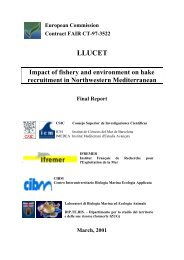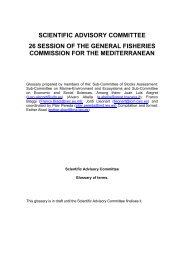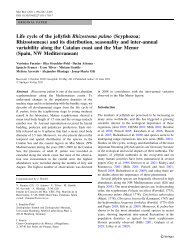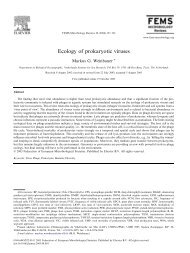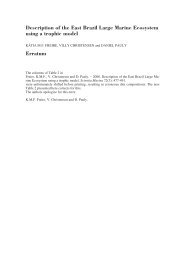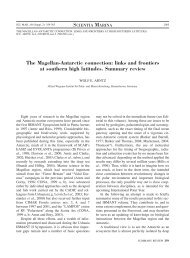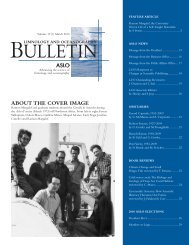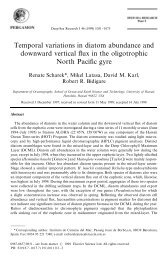REPORT OF THE WORKSHOP ON TRAWL SURVEY ... - FAO.org
REPORT OF THE WORKSHOP ON TRAWL SURVEY ... - FAO.org
REPORT OF THE WORKSHOP ON TRAWL SURVEY ... - FAO.org
You also want an ePaper? Increase the reach of your titles
YUMPU automatically turns print PDFs into web optimized ePapers that Google loves.
variation of catch rates did not vary with tow duration, except possibly for species with very<br />
low catch rates. For ocean pout on the Ge<strong>org</strong>e’s Bank, optimum tow length for maximum<br />
precision was around 10-15 minutes, allowing 30% more tows by reducing tow length from<br />
30 to 10 minutes. Comparative towing in the Bering Sea also showed no significant difference<br />
in length compositions for a range of species taken in 30-min and 15-min tows.<br />
An example of a comparative tow exercise to examine effects of tow duration was given in a<br />
Working Document to WKSAD(2005) by Wieland and Storr-Paulsen (“Effect of tow duration<br />
on catch rates and mean length of Northern shrimp (Pandalus borealis) and Greenland halibut<br />
(Reinhardtius hippoglossoides) in the Greenland Bottom Trawl Survey, 1999-2004”). Tows<br />
in this survey had been progressively reduced from 60 mins down to a mixture of 30min and<br />
15min tows, and an analysis of the effect of reducing all tows to 15mins was needed. A GLM<br />
approach where log (CPUE + 1) was modelled as a linear response to stratum, year, depth and<br />
tow duration, or to log (mean CPUE) and tow duration, indicated no significant effect of tow<br />
duration on catch rates or maximum size of shrimp or halibut.<br />
The WKSAD (2005) also presented results from an experiment to determine the catch rate of<br />
trawls during the periods before and after the official haul duration, and the potential for a<br />
“surprise” effect noted in some camera studies. This was done by carrying out “zero-duration”<br />
tows – i.e. where the net was retrieved as soon as it had settled adequately on the seabed at the<br />
official start of the tow. The study indicated that for less mobile species such as sole, the catch<br />
before and after the nominal haul duration may be proportional to tow duration during these<br />
brief periods, whereas for highly mobile species such as hake, the initial surprise effect may<br />
be more important, casting doubts on swept-area based abundance indices for such species. A<br />
significant surprise effect at the start of a tow could imply that surveys with many short tows<br />
of equal duration would perform better than having fewer longer tows that in some areas have<br />
to be reduced in duration for various operational reasons.<br />
Estimating biological parameters<br />
WKSAD(2005) examined the statistical basis for estimating biological parameters, treating<br />
the samples from individual tows as cluster samples. It was demonstrated that effective<br />
sample size to determine parameters such as length composition can be much smaller than the<br />
number of samples taken. This implies the need for more but smaller independent samples<br />
(another benefit of short tows). Spatial mapping and interpolating of biological parameters on<br />
acoustic surveys is also examined in the WKSAD report.<br />
Practical aspects of survey design and implementation: IBTSWG and SGSTS<br />
Trawl surveillance<br />
Trawl standardisation and inter-calibration of vessels and gears is a major topic addressed by<br />
IBTSWG and by SGSTS and its predecessor the SGSTG. Each national survey is expected to<br />
fully implement the strict protocols to ensure that their trawl gear fishes as consistently as<br />
possible, and to monitor trawl performance using suitable sensors. Good trawl surveillance<br />
data can clearly indicate the effects of changes in vessel or gear construction and deployment.<br />
The ICES SGSTS gives an example of the change in vessel by Cefas (Lowestoft) from the<br />
Cirolana to the Endeavour (Fig. 5) showing a significant increase in door spread and<br />
reduction in headline height of the GOV trawl when towed by the more powerful Endeavour.<br />
The 2005 and 2006 SGSTS reports devote considerable space to issues of trawl surveillance<br />
including the types of sensor that are available, the deployment, testing and calibration of<br />
47




